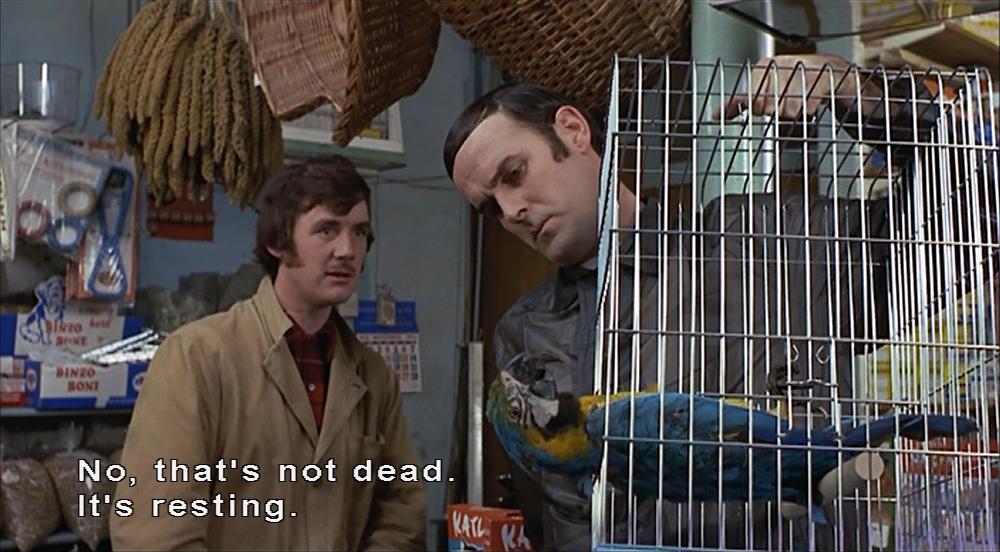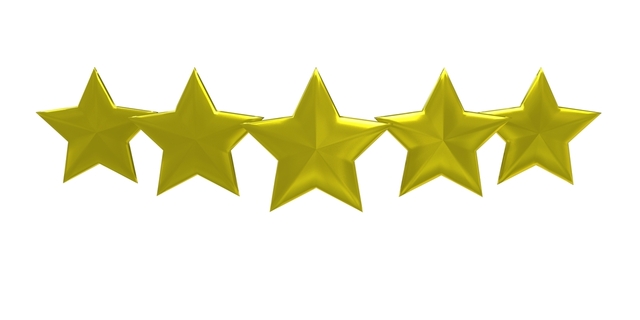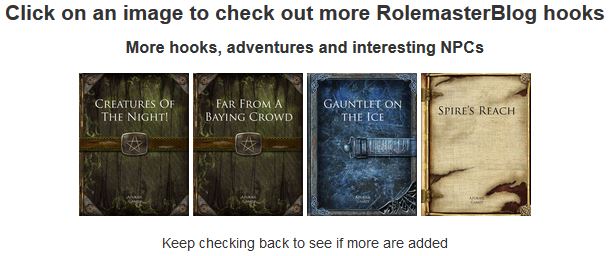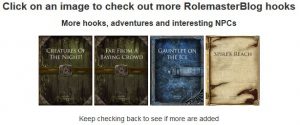The only things that RM really has that no other system comes close to is Arms Law with its descriptive criticals and black humour. Everything else is pretty run of the mill, the skills are the same skills found in just about every rpg, stats are stats. The spells are for the most part just reworkings of standard fantasy fare. The only stand out feature is the combat system.
But Arms Law doesn’t work and really has never really worked. How many times have you had someone stood behind a wall get hit in the leg? Why can you never shoot a dragon in the wing? Ignoring Size rules for a second why does a glancing blow from the jaws of a Tyrannosaurus Rex do the same damage as a glancing blow from a mouse? The promise or the premise was that to hot and damage were combined so a good hit did more damage than a hit that barely succeeded but you can roll a 1000+ with an open ended roll followed by a poor critical and do no more damage than a mediocre roll followed by a decent critical. In fact a roll totalling 150 is identical to a roll totalling 1000+ unless you start adding in optional or house rules. The promise of the better the attack roll the greater the damage doesn’t really work.
The criticals are supposed to add flavour and a gritty realism to combat but if the text refers to a body part that is impossible to hit, due to cover or doesn’t exist it just makes more work for the GM to translate the critical text into something viable.
I don’t think one can really call 10th level ‘high level’ in a game where there is an explicit range of 1st to 50th but a combat centric character can easily have an OB up around the +150 by 10th to 15th level with 20-30 ranks, plus a stat bonus, level bonus and superior weapon. So as long as you can roll more than the targets DB you will max out the table almost every single time.
Then there are the criticals against super large creatures. The whole idea of weapon specific damage does out the window at that point and everything from martial arts to crossbows do exactly the same damage effects.
Then we get to tiny through to huge attacks and rank one to four in martial arts. The idea of damage caps work for maximum damage but not for minimums, mice can out bite dragons.
One of the things that people asked for was attack tables that went over the 150 cap. The 175 cap really did nothing to solve the problem that caused the complaint in the first place. If anything the fact that RMU kicks off play at 3rd level makes the problem worse as characters will have table busting OBs sooner. The RMU solution is DB inflation with actively-passive-running-footworky-shieldy-dodgy-parryingmajiggy.
Arms Law does not work but we put up with it like an old dog that smells like a damp rug and farts constantly, because we love it and we could not imagine living without it.
The size rules attempted to solve the problem of an identical final attack roll from a mouse and a dragon bite doing the same damage, while removing the damage caps. This is the only thing that the size rules did well. If we use the compound tables with a bulk of the most common sizes all one table then you get a sticking plaster that functions in this particular instance.
The flaw is in the core Arms Law mechanic.
Roll the dice + skill + mods – DB -> look up the result, roll critical (if any).
This has never changed and is the core problem.
I am not suggesting this as a fully thought out solution, I am writing it on the hoof but…
If you took the bit that says +mods and moved it so that you get…
Roll the dice + skill – DB -> look up result, roll the critical (if any) + mods.
I have cheated a bit there as things like cover and magic and being stunned would effect DB but that is not what I want to focus on.
By adjusting the critical for size, something like +/-10 for each size step difference may work. Rearrange the results so the lowest critical results are feet and shins and the highest are shoulders, neck and head and you have a result that mice would be really pushed to ever bite a giant above the knee and if a dragon takes a swipe at you it is unlikely to hit your foot.
One of the breaking 150 options was to add +1 to the critical roll for every 10 over 150. This would work perfectly well. Now rolling up in the multiple hundreds would make a difference. You would not be rolling 500+ and then getting a critical of 01 and no bonus.
You can scrap criticals A to E and just have 100 possible critical results on a linear scale, maybe 2% or 5% apart. Now all criticals can be open ended!
Size need not be the only critical mod. If DB is about hit or miss, that is where parry belongs. Shields on the other hand can be used to turn a blow away, thus adding to DB, or by putting the shield in the way thus protecting the person so that can be used as a critical mod.
Cover may not add to your DB but it could protect against criticals from 01-30 for a low wall or from 31-80 if you are stood behind a cart with your head and feet visible but the rest of your middle section hidden.
Weapons could come with a critical mod. You are highly unlikely to stab someone in the foot with a dagger as you would have to really reach down intentionally to do so. A battle axe though is probably more likely to do a wound to the lower half of the body, (I stand to be corrected there as I am just spieling off ideas as they come to me). I can imagine parrying an axe coming down at my head or shoulders but the momentum and follow though taking the axe head down to the legs or even feet. As long as the size mods out weighed the weapon adjustments you are still most likely to get stabbed by a hobbit in your leg or abdomen, not the neck or shoulder.
All of a sudden you don’t need the size based multiples and reading up or down a critical tables in multiples of +/-10 is much much easier to do on the fly.
We no longer need this forced size multiples such as charging adding +1 size, now that becomes a critical mod. You even get to finesse things by making charging a penalty to hit, after all you are running around, but a bonus to the critical.
You do not even need the attack table any more. The attack roll becomes a 101+ skill check. You can combine the damage that would have been on the table into the critical descriptions so the skill roll is little more than a pass/fail/fumble roll.
If you combine armour references into the criticals e.g. If foe has a helm then +12 hits, otherwise foe is stunned 3 rounds +22hits. You now can roll out location specific armour and armour by the piece. Imagine an electricity critical ‘Strike to the upper arm, if foe has metal armour then it is fused into a single piece -20 to all actions using that arm +20 hits, stunned 2 rounds. If organic armour then armour is destroyed +10 hits else, +15hits and burning 1 hit/rnd.’
We can add in breakage so all attacks are two d100 rolls either attack/fumble, attack/breakage check or attack/critical. That is nice and consistent with every action being two rolls ALWAYS.
Another alternative is that you have a traditional attack table of sorts but scrap criticals A-E. You now rename the columns Legs, Arms, Abdomen, Torso, Neck/Head. This makes it relatively easy to do called shots, you take a penalty to hit but choose the column for the critical. Weapons tables skew the columns to match the sort of weapon. So knives and daggers that are unlikely to hit something out of arms reach, like the feet do more arm, abs and torso criticals. Cover exclude unreachable criticals and position shifts the column left or right so attacking from above is more likely to hit the head than the feet. In this system you could have a single page of additional Krush, Puncture and Slash Criticals but with columns for Wing, Tail, Tentacle and Fin. If a beast doesn’t have legs then the GM can substitute the tail column, if there are no arms then you attack the fins. Another creature may be all tentacles, head, body tail.
Arms Law was probably conceived on a wet Wednesday afternoon are a particularly dissatisfying D&D combat. Since that time it has remained basically unchanged for going on 40 years and not one of its shortcomings have ever been addressed.
The ideal solution may well be a combination of all of the above or things I have not even dreamt of but the fiddling around the edges of RMU’s Arms Law is not the right solution and solves nothing.
Extending the maximum result to 175 compared to 150 does nothing especially if people walking around with a +285OB. The 175 cap is a drop in the ocean. The most powerful PC I ever had had an OB of +193. It was extremely unusual for me not to do an E critical on almost every round. I don’t thinking going to 175 would have changed that.
To round it off, I think Arms Law is the heart of Rolemaster and unless it is looked at really critically and made fit for purpose then all the tweaks in the world will just make it slower and more cumbersome and not solve the real problems.
















